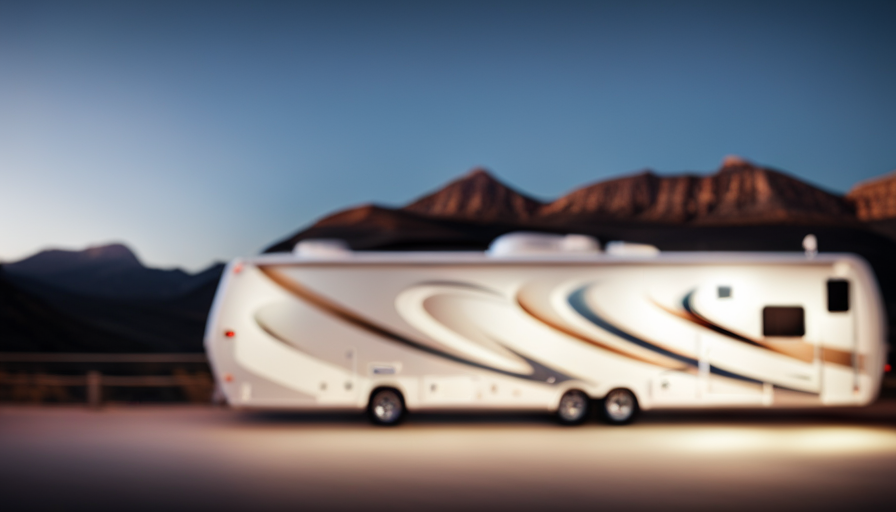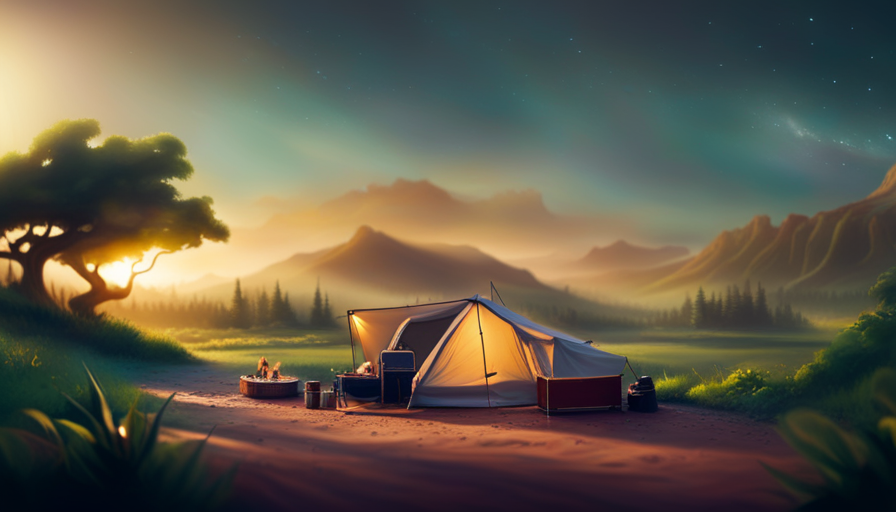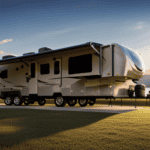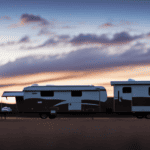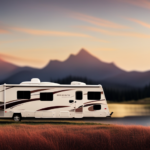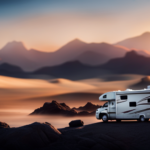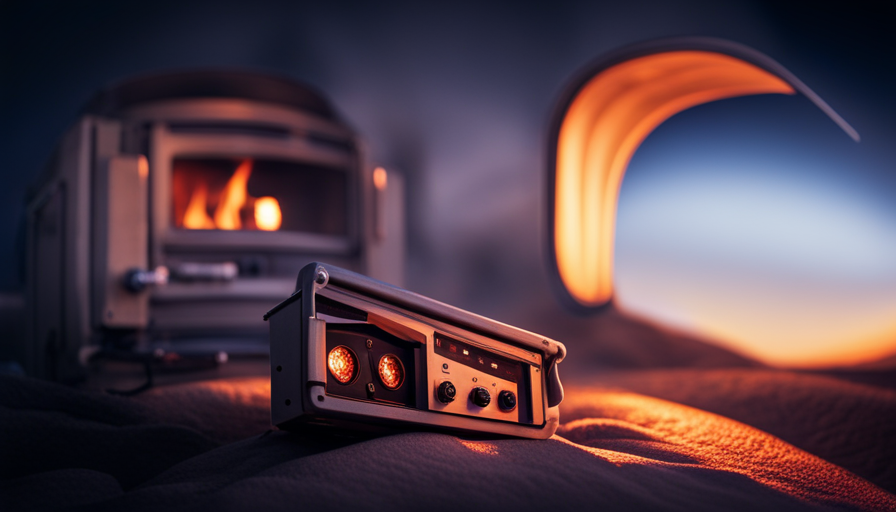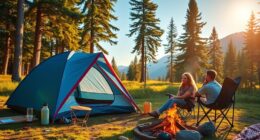Immerse yourself in the realm of excitement and liberation with the irresistible charm of a 5th wheel camper. Similar to a magnificent eagle gliding through the vast sky, these exceptional vehicles provide a distinctive and exhilarating method to discover the beauty of nature. Envision yourself cruising down the highway, feeling the breeze in your hair and the sunlight on your face, as you set off on memorable adventures and build precious moments.
A 5th wheel camper is a towable recreational vehicle that is hitched to the bed of a pickup truck, providing a spacious and comfortable living space for travelers. With their distinctive design and numerous features, these campers are ideal for those seeking the perfect blend of comfort and mobility. From luxurious amenities to innovative storage solutions, a 5th wheel camper has it all.
In this article, we will delve into the world of 5th wheel campers, exploring their definition, features, advantages, and much more. Whether you’re a seasoned camper or new to the world of RVing, join us as we unravel the wonders of these remarkable vehicles and discover if a 5th wheel camper is the right choice for you.
Key Takeaways
- 5th wheel campers are towable recreational vehicles hitched to the bed of a pickup truck, providing spacious and comfortable living space.
- They are larger than traditional travel trailers and often equipped with amenities such as a full kitchen and bathroom.
- Owning a 5th wheel camper offers advantages such as spacious living with multiple slide-outs, better towing stability, and abundant storage space.
- Considerations for owning a 5th wheel camper include choosing the right size, matching the weight and towing capacity of the vehicle, and regular maintenance and care.
Definition and Features of a 5th Wheel Camper
If you’re looking for a spacious and luxurious camping experience, you’ll love what a 5th wheel camper has to offer. A 5th wheel camper, also known as a fifth-wheel trailer, is a type of recreational vehicle that is towed by a pickup truck using a special hitch.
This unique design provides several advantages over other types of campers. One of the main advantages of a 5th wheel camper is its spaciousness. These campers are typically larger than traditional travel trailers, offering more living space and storage options. This makes them ideal for long trips or for those who prefer a more comfortable camping experience. Additionally, the layout of a 5th wheel camper is often well thought out, with separate living and sleeping areas, and even amenities such as a full kitchen and bathroom.
However, it’s important to consider the disadvantages as well. Due to their size and weight, 5th wheel campers require a pickup truck with a special hitch for towing. This means that you may need to invest in a larger vehicle if you don’t already have one. Additionally, maneuvering a 5th wheel camper can be more challenging than with other types of campers, especially in tight spaces.
Despite these potential drawbacks, the advantages of owning a 5th wheel camper far outweigh the disadvantages. So, let’s dive into the benefits of owning one.
Advantages of Owning a 5th Wheel Camper
Owning a 5th wheel brings a sense of freedom and adventure like no other. The benefits and features of these campers make them a popular choice among outdoor enthusiasts. Here are a few advantages of owning a 5th wheel camper:
-
Spacious Living: 5th wheel campers offer ample living space, with multiple slide-outs that expand the interior when parked. This allows for comfortable seating, dining, and sleeping arrangements, making it feel like a home away from home.
-
Towing Stability: These campers are designed to be towed by a pickup truck, which provides better stability compared to other types of RVs. The unique hitching system, known as the fifth wheel, ensures a secure connection between the trailer and the truck, resulting in a smoother towing experience.
-
Storage Capacity: One of the standout features of a 5th wheel camper is its abundant storage space. From large exterior compartments to hidden storage areas inside, you can bring along all the gear and supplies you need for your adventures.
-
Luxurious Amenities: Many 5th wheel campers come equipped with high-end amenities such as full kitchens, bathrooms, entertainment systems, and even fireplaces. These luxurious features enhance your camping experience and provide all the comforts of home.
Choosing the right 5th wheel camper for your needs is essential in ensuring a satisfying camping experience. Stay tuned to learn more about the factors you should consider when making this decision.
How to Choose the Right 5th Wheel Camper for Your Needs
When it comes to finding the perfect 5th wheel companion, your needs and desires will be the compass guiding you towards your ultimate adventure vehicle.
One of the most important factors to consider is choosing the right size. You want to ensure that the 5th wheel camper you choose is spacious enough to accommodate your needs, but not so large that it becomes difficult to tow and maneuver. Take into account the number of people who’ll be traveling with you and the amount of storage space you require for all your gear.
Another crucial aspect to consider is your towing vehicle. It’s essential to match the weight and towing capacity of your vehicle with the weight of the 5th wheel camper you’re considering. You should consult your vehicle’s owner’s manual or contact the manufacturer to determine its towing capabilities. This’ll ensure a safe and smooth towing experience.
Understanding the hitching process is the next step in your journey towards owning a 5th wheel camper. This involves attaching the 5th wheel camper to your towing vehicle using a specialized hitch. We’ll delve into this process in the subsequent section to provide you with all the necessary information for a successful hitching experience.
Understanding the Hitching Process
Mastering the hitching process will empower you to embark on a seamless and exhilarating journey with your perfect adventure companion. To ensure a safe and hassle-free experience, it’s essential to follow a few safety precautions during the hitching process.
-
Safety Precautions:
- Always inspect the hitch, coupler, and safety chains for any signs of wear or damage before starting the hitching process.
- Make sure the trailer is level and properly chocked to prevent it from rolling or shifting during hitching.
- Double-check that the electrical connections are secure and functioning correctly to ensure proper brake and signal lights operation.
-
Common Mistakes:
- Failing to properly align the hitch and coupler can lead to difficulty in latching or even damage to the trailer or towing vehicle.
- Forgetting to engage the hitch lock or safety pin can result in the trailer becoming unhitched while on the road.
- Overlooking the weight distribution and tongue weight can cause stability issues, affecting the overall towing performance.
By understanding and implementing these safety precautions and avoiding common mistakes, you can confidently hitch your 5th wheel camper and be on your way to unforgettable adventures.
Moving forward, let’s explore the essential maintenance and care for your 5th wheel camper.
Maintenance and Care for Your 5th Wheel Camper
To ensure your 5th wheel adventure companion remains in top condition, regularly maintaining and caring for it is crucial. Here are some maintenance tips to keep your 5th wheel camper in great shape.
Firstly, it’s important to inspect the exterior regularly for any signs of damage or wear. Check for any cracks, leaks, or loose parts and address them immediately. Don’t forget to inspect the roof for any damage or potential leaks as well.
Additionally, make sure to clean the exterior regularly to remove dirt, debris, and any other substances that may cause damage over time.
Another important aspect of maintenance is taking care of the interior. Keep the living area clean and organized, and regularly check for any signs of pests or moisture. It’s also essential to inspect and maintain the electrical and plumbing systems. Check for any loose connections, leaks, or any other issues that may affect the functionality of these systems.
Common issues that may arise with 5th wheel campers include tire wear, battery problems, and brake issues. Regularly inspecting and maintaining these components will help prevent any major issues on the road.
By following these maintenance tips, you can ensure that your 5th wheel camper remains in top condition for all your camping adventures.
Speaking of adventures, let’s now transition to the subsequent section about popular destinations for 5th wheel camping.
Popular Destinations for 5th Wheel Camping
Now that we’ve discussed the importance of maintenance and care for your 5th wheel camper, let’s move on to the exciting part – planning your camping trips!
There are so many incredible destinations out there that are perfect for 5th wheel camping.
When it comes to choosing the best time for your camping adventure, it really depends on your personal preferences and the climate of the area you’re planning to visit. Some people enjoy the tranquility of camping during the off-season, while others prefer the hustle and bustle of peak tourist season. Researching the weather patterns and peak seasons of your desired destinations will help you determine the ideal time for your trip.
In addition to timing, having the right gear is essential for a successful 5th wheel camping experience. Some must-have items include leveling blocks, wheel chocks, a sewer hose kit, and a surge protector. These items will ensure that your camper is stable, secure, and equipped for any unforeseen circumstances.
As we move forward, we’ll provide you with valuable tips for a successful 5th wheel camping trip, including how to choose the perfect campground, set up your campsite efficiently, and make the most of your time in the great outdoors.
Tips for a Successful 5th Wheel Camping Trip
When planning a successful 5th wheel camping trip, it’s crucial to research and select the perfect campground that offers the amenities and activities that align with your interests and preferences. Here are three tips to ensure a memorable and enjoyable adventure:
-
Pack Efficiently: Make a checklist of essential items such as bedding, kitchen supplies, toiletries, and outdoor gear. Utilize storage compartments in your 5th wheel camper efficiently by using collapsible containers and vacuum-sealed bags. Don’t forget to bring extra batteries and a first aid kit for any unforeseen situations.
-
Best Time of Year to Go 5th Wheel Camping: The ideal time to embark on a 5th wheel camping trip depends on your destination. Spring and fall offer pleasant weather conditions, fewer crowds, and breathtaking natural scenery. However, summer is perfect for enjoying water activities and festivals. Winter camping can be adventurous, but ensure your 5th wheel camper is equipped for colder temperatures.
-
Research Campground Rules and Regulations: Before you arrive, familiarize yourself with the campground’s rules and regulations. Some may have specific noise restrictions, pet policies, or generator usage guidelines. Additionally, check if reservations are required, as popular campgrounds tend to fill up quickly during peak seasons.
By following these tips, you’ll be well-prepared for a successful 5th wheel camping trip. In the next section, we will address common misconceptions about 5th wheel campers, shedding light on the truth behind these beliefs.
Common Misconceptions About 5th Wheel Campers
Contrary to popular belief, 5th wheel camping is not limited to retirees. Statistics show that the average age of 5th wheel owners is decreasing, with more young families and adventure seekers embracing this form of outdoor recreation. Despite this, there are still some common misconceptions about 5th wheel campers that persist.
One of the most common misconceptions is that 5th wheel campers are difficult to tow. While it’s true that these campers are larger and require a special hitch, they are actually quite easy to tow once you get the hang of it. Many new models are designed with maneuverability in mind, making them easier to navigate on the road and in tight camping spots.
Another misconception is that 5th wheel campers are expensive. While it’s true that they can be a significant investment, they often provide more living space and amenities compared to other types of RVs. Additionally, there is a wide range of options available, allowing you to find a 5th wheel camper that fits your budget.
Like any form of camping, there are advantages and disadvantages to 5th wheel camping. Some advantages include the spaciousness and comfort of the living area, the ability to detach the camper and use your vehicle for exploration, and the option to bring along more amenities. However, some disadvantages include the need for a larger towing vehicle, limited maneuverability in some camping areas, and the additional maintenance and storage requirements.
There are several common misconceptions about 5th wheel campers. However, with the increasing popularity of this form of camping, more and more people are discovering the advantages and enjoying the freedom it offers.
Now, let’s hear some testimonials from 5th wheel camper owners who’ve experienced the joys of this outdoor lifestyle.
Testimonials from 5th Wheel Camper Owners
Testimonials from 5th wheel camper owners reveal the unparalleled sense of freedom and adventure that comes with embracing this outdoor lifestyle. Being part of RV communities allows us to connect with like-minded individuals who share our passion for exploration. These communities provide a sense of camaraderie, as we swap stories around the campfire and create lasting friendships.
One of the great advantages of owning a 5th wheel camper is the cost of ownership. Compared to other types of recreational vehicles, 5th wheels tend to be more affordable. The initial investment may seem daunting, but the long-term savings are worth it. The cost of maintenance and repairs is generally lower, as the structure is lighter and easier to handle than larger motorhomes.
Moreover, 5th wheel campers offer spacious living areas, allowing us to bring along all the comforts of home. From fully equipped kitchens to cozy bedrooms, these campers provide a comfortable and convenient way to travel. We can enjoy picturesque views from large windows and relax in comfortable seating areas.
Is a 5th wheel camper right for you? Stay tuned to find out as we explore the various considerations and factors to help you make an informed decision about embracing the 5th wheel camper lifestyle.
Conclusion: Is a 5th Wheel Camper Right for You?
So, are you ready to embark on your next adventure and discover if a 5th wheel camper is the perfect fit for you? Let’s weigh the pros and cons of owning a 5th wheel camper and consider the factors to take into account before making a purchase.
Pros of owning a 5th wheel camper include spaciousness, as these campers offer more living area compared to other types of RVs. They also provide a separate bedroom, making it feel more like a home away from home. Additionally, 5th wheel campers often have more storage space, allowing you to bring along all your essentials for an extended trip.
However, there are also some cons to consider. One major factor is the size and weight of a 5th wheel camper, which requires a heavy-duty truck for towing. This can be a significant investment if you don’t already own a suitable vehicle. Another consideration is the maneuverability of a 5th wheel camper, as they can be more challenging to navigate in tight spaces or crowded campgrounds.
Before buying a 5th wheel camper, it’s important to think about your specific needs and preferences. Consider factors such as your desired travel destinations, budget, and the amount of time you plan to spend on the road. Research different models and floor plans to find one that fits your lifestyle.
Owning a 5th wheel camper can offer many advantages, but it’s crucial to carefully weigh the pros and cons and consider your individual circumstances before making a decision. Happy camping!
- Freedom to travel and explore new places
- Comfort and convenience of a home on wheels
- Opportunities for memorable family bonding time
Frequently Asked Questions
How much weight can a 5th wheel camper tow?
When it comes to towing capacity, 5th wheel campers are like Herculean workhorses! These bad boys can handle some serious weight, allowing you to bring along all the essentials for your camping adventure.
The towing capacity of a 5th wheel camper greatly affects its performance, as it determines how much weight it can safely tow. Compared to traditional RVs, 5th wheel campers offer several advantages, such as increased stability, better maneuverability, and more living space.
So, you can enjoy a smooth and comfortable ride while bringing all your favorite gear along for the journey!
Are 5th wheel campers more expensive than traditional RVs?
When comparing 5th wheel campers to motorhomes, it’s important to consider which option is a better investment.
In terms of advantages, 5th wheel campers offer several benefits over traditional RVs. They typically provide more living space, thanks to their unique design that extends over the bed of a pickup truck. Additionally, they tend to have higher weight capacities and better stability on the road. These factors, along with potentially lower costs, make 5th wheel campers a popular choice among RV enthusiasts.
Can a 5th wheel camper be towed by a regular pickup truck?
Yes, a 5th wheel camper can be towed by a regular pickup truck. The towing capacity of the truck is crucial in determining if it can handle the weight of the camper. Different truck models have varying towing capacities, so it’s important to check the specifications of your truck before attempting to tow a 5th wheel camper. Make sure your truck is compatible with the weight and size of the camper for a safe and enjoyable towing experience.
What type of maintenance is required for a 5th wheel camper?
When it comes to 5th wheel camper maintenance, there are a few key areas to focus on. Regular inspections of the roof, tires, and brakes are essential. Checking for any signs of water damage, such as leaks or soft spots, is crucial to prevent further issues.
Additionally, keeping the exterior clean and well-maintained will help preserve its longevity. Common issues to watch out for include electrical problems, plumbing leaks, and wear and tear on the slide-out mechanisms. Regular maintenance will ensure a smooth and trouble-free camping experience.
Are there any restrictions on where you can park or camp with a 5th wheel camper?
When it comes to parking and camping with a 5th wheel camper, there are certain restrictions to be aware of. Depending on the location, there may be parking restrictions that limit where you can park your camper. It’s important to check local ordinances and regulations to ensure compliance.
Additionally, some campsites may have specific restrictions on the size or type of camper allowed. Researching and planning ahead will help ensure a smooth and enjoyable camping experience.
How Does a Slide In Camper Differ from a 5th Wheel Camper?
A slide in camper is a portable living space that slides into the bed of a pickup truck, while a 5th wheel camper attaches to the bed of a truck using a specialized hitch. Each offers unique advantages slide in campers are more versatile, while 5th wheel campers provide a larger living area and better stability during travel. Understanding the slide in camper basics can help you decide which option suits your camping needs best.
Conclusion
In conclusion, after considering all the advantages, features, and testimonials from 5th wheel camper owners, it’s clear that owning a 5th wheel camper is an absolute game-changer for any camping enthusiast. The level of comfort, convenience, and space it provides is simply unmatched.
It’s like having a luxurious home on wheels! So, if you want to take your camping experience to the next level and enjoy the ultimate in comfort and convenience, a 5th wheel camper is definitely the way to go. Don’t miss out on this incredible opportunity to elevate your camping adventures to new heights!

